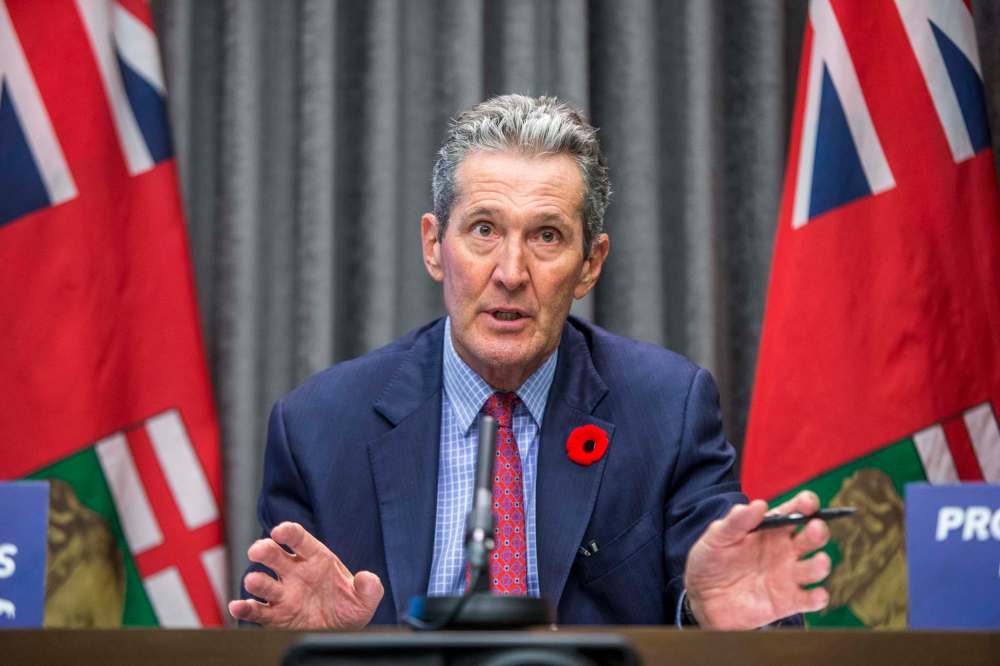Pallister defends provincial business relief programs
Advertisement
Read this article for free:
or
Already have an account? Log in here »
To continue reading, please subscribe:
Monthly Digital Subscription
$0 for the first 4 weeks*
- Enjoy unlimited reading on winnipegfreepress.com
- Read the E-Edition, our digital replica newspaper
- Access News Break, our award-winning app
- Play interactive puzzles
*No charge for 4 weeks then price increases to the regular rate of $19.00 plus GST every four weeks. Offer available to new and qualified returning subscribers only. Cancel any time.
Monthly Digital Subscription
$4.75/week*
- Enjoy unlimited reading on winnipegfreepress.com
- Read the E-Edition, our digital replica newspaper
- Access News Break, our award-winning app
- Play interactive puzzles
*Billed as $19 plus GST every four weeks. Cancel any time.
To continue reading, please subscribe:
Add Free Press access to your Brandon Sun subscription for only an additional
$1 for the first 4 weeks*
*Your next subscription payment will increase by $1.00 and you will be charged $16.99 plus GST for four weeks. After four weeks, your payment will increase to $23.99 plus GST every four weeks.
Read unlimited articles for free today:
or
Already have an account? Log in here »
Hey there, time traveller!
This article was published 05/11/2020 (1861 days ago), so information in it may no longer be current.
Premier Brian Pallister is stepping back from painting Manitoba’s business-assistance programs as the “most generous” in Canada, but he still incorrectly maintains they’re “the most effective in the country.”
It’s a distinction that business owners, wage-earners and commerce stakeholders believe is inconsequential in the long run — warning unemployment caused during a second wave of COVID-19 in the province will lead to a “third wave of layoffs” well into next year, should the Tory government fail to step up with more support.
At a press conference Thursday, Pallister did not directly answer questions from the Free Press about provincial relief restrictions.

Asked why anyone who accesses emergency federal funds is automatically ineligible for provincial business assistance, the premier deferred to his personal experience in the business sector and incorrectly touted Manitoba’s support programs as “better than anywhere else.”
“I can tell you we are leading the country in getting people back to work,” Pallister told reporters. “Am I open to hearing from business leaders? Absolutely. But I’ve never heard a business lobbyist ever lobby for less money and less support.”
According to figures from Statistics Canada, released before the surge of new coronavirus cases and deaths in the province, Manitoba falls behind provinces like Saskatchewan, Nova Scotia and British Columbia in employment rates. Economists from the Conference Board of Canada predict unemployment numbers will grow even larger in the province when labour force data for late October and early November is released.
And recent polling from the Canadian Federation of Independent Business finds Manitoba ranking behind almost all other provinces in terms of COVID-19 support “being helpful” — including Saskatchewan, Alberta, Nova Scotia, Prince Edward Island, Quebec and British Columbia. Only 10.4 per cent businesses polled found funding in the province “somewhat helpful,” with 19.5 per cent saying it was “not helpful at all.”
In a statement to the Free Press Thursday, a provincial spokesperson cited uptake numbers from funding by the province as a sign of success and effectiveness of Manitoba’s business-assistance programs — providing figures for one-time loans such as the $6,000 Manitoba Gap Protection Program (currently offered only to businesses that don’t qualify for federal aid); the Back to Work subsidy offering 50 per cent reimbursements for wages paid to new employees hired after June; and Manitoba Public Insurance rebates of between $140 and $160.
But the provincial data shows only $8.2 million out of the combined $120 million allocated under the Gap Protection and Job Restart Program has actually been paid out. And under the combined budget of $120 million for the Back to Work in Manitoba, Back to Work This Summer and Student Wage Subsidy programs, $8.3 million has been paid to date.
None of those provincial numbers account for funding that would have to be returned if a business qualified for, or received, federal funding after getting provincial relief.
“It’s simply incorrect when you say that our programs are currently helpful for businesses,” said Jonathan Alward, CFIB’s director in Manitoba. “While we really thought this kind of support was good earlier in the year, it’s definitely time for more to be done now — it’s not summer anymore.”
Loren Remillard, president of the Winnipeg Chamber of Commerce, pointed to several businesses that are letting go of their staff as a result of code-red restrictions in the city. “They have yet to benefit from these programs that haven’t changed much or at all since they were first launched,” he said in an interview.
“The fact is,” added Remillard, “when people continue to be laid off, it’s federal support they will have to turn to.
“What the province can do now is help by making sure there is support for businesses to keep them viable, so there is a better way around unemployment rising and more layoffs happening.”
Twitter: @temurdur
temur.durrani@freepress.mb.ca






